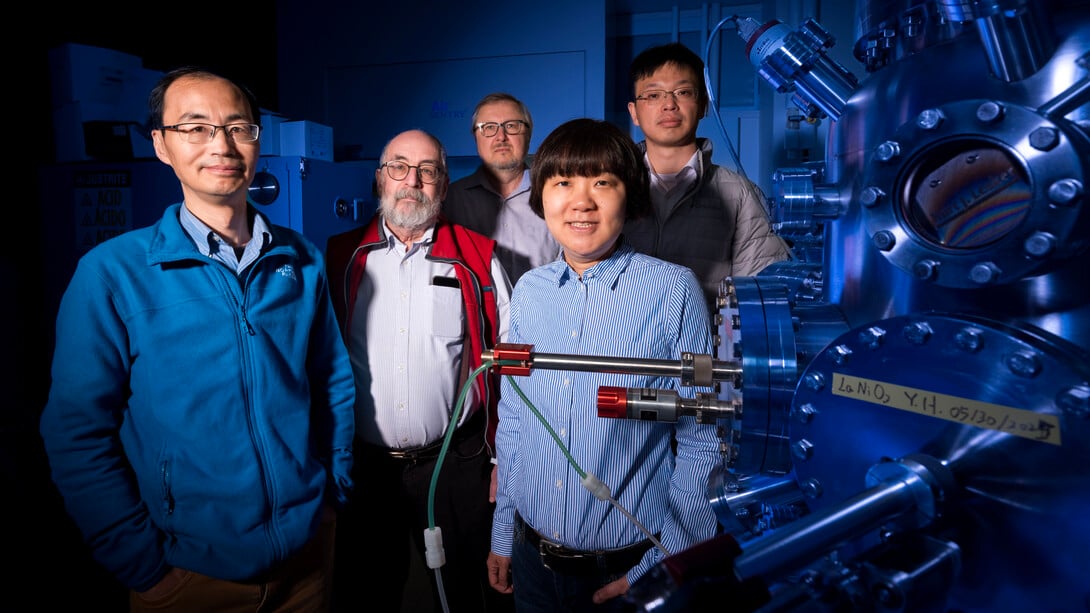Science
University of Nebraska Secures $2.5 Million Grant for Quantum Research

The University of Nebraska–Lincoln has received a significant boost in its quantum research efforts with a new grant of $2.5 million from the national Department of Energy’s Established Program to Stimulate Competitive Research (EPSCoR). This funding will support a project focused on the innovative use of ferroelectric oxides to study emergent quantum phases and design more efficient electronic devices.
Led by Xia Hong, a professor of physics and astronomy, the research team comprises seven members who aim to leverage ferroelectric oxides to manipulate oxide and van der Waals materials in groundbreaking ways. These methods include switching between metallic and insulating states or altering magnetic properties. “The overarching goal is to use nanoscale control of ferroelectricity to induce a new state of matter,” said Hong.
Expanding Quantum Materials Expertise
This two-year grant marks the third notable award to scientists associated with Nebraska’s Emergent Quantum Materials and Technologies (EQUATE) Center in recent months. Earlier, a team led by Christian Binek, the Paula and D.B. Varner Professor of Physics and EQUATE director, received a $1.8 million grant from the National Science Foundation’s EPSCoR program to explore novel two-dimensional materials. Additionally, an international team led by Evgeny Tsymbal, the George Holmes Distinguished Professor of physics, was awarded $2 million to develop materials aimed at revolutionizing future technologies.
“These awards build on the momentum created when EQUATE was established nearly five years ago with a $20 million NSF grant,” Binek noted. “They will allow us to continue pursuing this significant area of research and to expand our expertise in quantum materials science here in Nebraska.”
The EPSCoR grant, titled “Emergent Interface Phenomena Enabled by Ferroelectric Oxide Thin Films and Membranes,” places a strong emphasis on workforce development. The South Dakota School of Mines and Technology is collaborating on this project, which is renewable for up to four additional years. The funding will facilitate the development of infrastructure in both Nebraska and South Dakota while supporting three early-career scientists, including Zuocheng Zhang, an assistant professor at the University of Nebraska–Lincoln, and Tula Paudel and Alexey Lipatov, both assistant professors at the South Dakota School of Mines.
Research Goals and Innovations
In addition to their research duties, team members will employ graduate students and postdoctoral researchers, with undergraduate students also participating in the project. Other members of the research team include Peter Dowben, Xiaoshan Xu, and Tsymbal. Hong emphasized that the EPSCoR initiative focuses not only on research but also on infrastructure and human resource development.
The grant encompasses three primary research thrusts. The first aims to investigate the interface between ferroelectric oxides and strongly correlated oxides, targeting reversible quantum phase transitions, such as switching from a metal to an insulator. By utilizing ferroelectric polarization instead of traditional methods like high pressure or chemical substitutions, the team hopes to develop a low-voltage control mechanism suitable for binary logic and memory devices.
“This is our competitive edge — we have a new technique that is very special and energy efficient,” Hong stated. The second area of focus involves multiferroic systems that feature both ferroelectricity and magnetism, with various doping methods employed to convert ferroelectric insulators into polar metals, potentially allowing for low-energy data storage through electric field manipulation of magnetic states.
The third thrust aims to create superlattices of ferroelectric domains to engineer new electronic and optical properties in two-dimensional van der Waals materials. By adjusting the rotation angle between oxide layers using stacking techniques, the research could lead to the emergence of new electronic and magnetic states.
If successful, this research has the potential to pave the way for innovations in consumer electronics, including smartphones and other devices, enhancing performance while reducing energy consumption.
Despite the high stakes, Hong reflects on the intrinsic motivation driving her team: “The beauty of fundamental science is that, even when you don’t see the impact right away, you are motivated by curiosity and the beauty of nature, and the fascination with how things behave.”
-

 Science2 weeks ago
Science2 weeks agoUniversity of Hawaiʻi Joins $25.6M AI Project to Monitor Disasters
-

 Business3 weeks ago
Business3 weeks agoForeign Inflows into Japan Stocks Surge to ¥1.34 Trillion
-

 Top Stories3 weeks ago
Top Stories3 weeks agoBOYNEXTDOOR’s Jaehyun Faces Backlash Amid BTS-TWICE Controversy
-

 Top Stories3 weeks ago
Top Stories3 weeks agoMarc Buoniconti’s Legacy: 40 Years Later, Lives Transformed
-

 Health4 weeks ago
Health4 weeks agoInnovative Surgery Restores Confidence for Breast Cancer Patients
-

 Sports1 month ago
Sports1 month agoSteve Kerr Supports Jonathan Kuminga After Ejection in Preseason Game
-

 Top Stories3 weeks ago
Top Stories3 weeks agoCarson Wentz Out for Season After Shoulder Surgery: Urgent Update
-

 Science1 month ago
Science1 month agoChicago’s Viral ‘Rat Hole’ Likely Created by Squirrel, Study Reveals
-

 Entertainment1 month ago
Entertainment1 month agoZoe Saldana Advocates for James Cameron’s Avatar Documentary
-

 Lifestyle1 month ago
Lifestyle1 month agoKelsea Ballerini Launches ‘Burn the Baggage’ Candle with Ranger Station
-

 Lifestyle1 month ago
Lifestyle1 month agoDua Lipa Celebrates Passing GCSE Spanish During World Tour
-

 Politics1 month ago
Politics1 month agoDallin H. Oaks Assumes Leadership of Latter-day Saints Church







